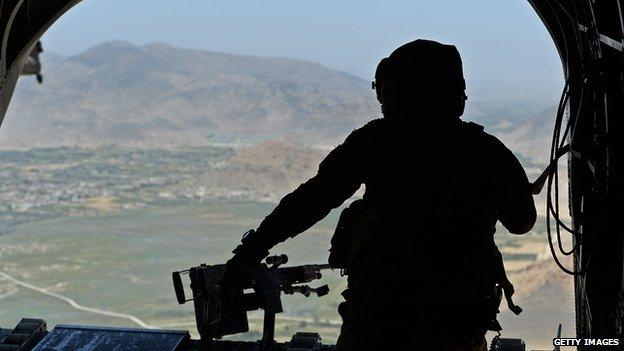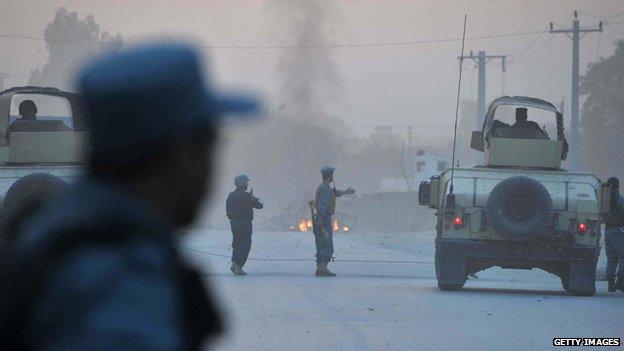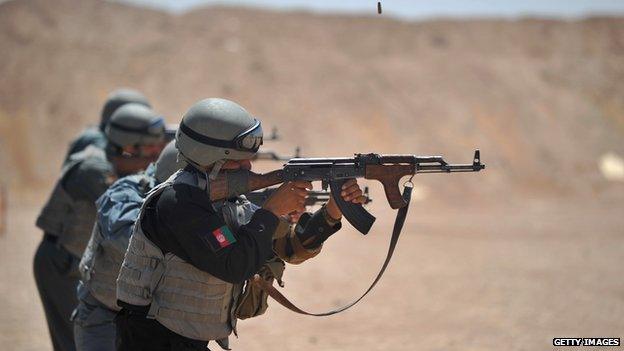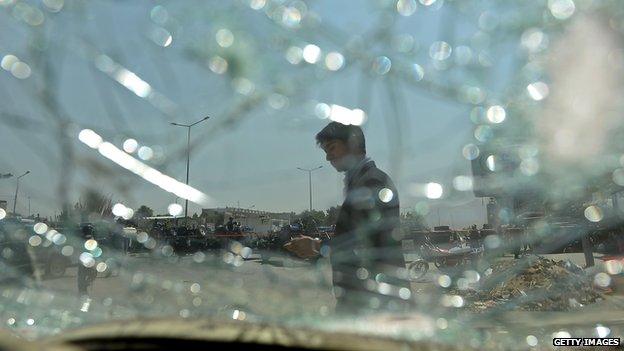Viewpoint: How Nato can help make Afghan forces sustainable
- Published

As the Nato summit in Wales approaches, guest columnist Lotfullah Najafizada looks at how the Afghan army has fared since international troops started to withdraw. He argues that Nato should continue funding the army in order to make it a sustainable force to be reckoned with and put enough pressure on the Taliban to bring about a peace deal.
In his closing press conference at the Nato summit in Chicago in May 2012, US President Barack Obama said the alliance had a clear roadmap ahead in Afghanistan: handing over combat operations to the Afghan forces, with the US-led Nato mission assuming a support role. With the next Nato summit about to begin, one thing is certain: Afghan forces have held up their part of the deal and more.
Army successes
The 352,000-strong Afghan National Security Forces (ANSF) have engaged with the Taliban and other insurgent groups 150 times a day during the 2014 summer fighting season.
The fight is tough, the ANSF sacrifices are immense, but the Taliban - backed by foreign fighters in the battlefield this year - are not taking control of districts and small towns, let alone cities and populated areas. This is in direct contrast to the dire predictions of some, who foresaw that the Taliban would retake districts less than 24 hours after the departure of foreign troops.
Nato has departed from more than 800 bases and outposts across Afghanistan since the last Nato summit. Today, there are just over 40,000 Nato troops in Afghanistan, a third of the size of the Nato force in 2012. In May 2012, the same month of the Chicago summit, 56 Nato troops - including 40 Americans - died in the battlefield, but in the month leading to the Wales summit, there have been just five casualties.

An intensified army presence at this year's polls brought about a larger turnout than in previous years
Fewer casualties on the part of Western troops is not an indication that the war is over and the enemy has been defeated. The heat is instead being taken by Afghan troops: a minimum of 15 Afghan forces have died each day during this year's fighting season and there are insurgent-related incidents every day across 20 Afghan provinces - almost two thirds of the country.
Despite such pressure, Afghan forces secured two rounds of national elections this spring and summer, allowing millions of Afghans to vote across Afghanistan. Under the ANSF umbrella, the turnout was higher and the elections were safer than the 2009 elections, when President Obama began his military surge, enlarging the US military footprint in Afghanistan to 100,000 troops.
Now, when President Obama, his host British Prime Minister David Cameron, Nato Secretary General Anders Fogh Rasmussen and another two dozen leaders from other Nato countries convene in Cardiff this week, they should keep their promise: continue to support the Afghan forces.
Forgotten warriors
The Afghan army is a post-civil war one: it is fragile. Neighbours have already questioned the size of the Afghan army and some elements within the region's armies do all they can to undermine the Afghan forces in their first real test in leading combat.
Neither success nor failure could be ruled out at this stage. The domestic Afghan political environment is another threat facing the Afghan forces. President Hamid Karzai has banned his forces from seeking air support from their Nato counterparts, due to stated concerns over air strikes killing civilians. This policy may have prevented civilian deaths in Afghan villages, but it has also turned the battlefield deadly for the young Afghan men in uniform.

The banning of Nato air support may have led to more casualties in the Afghan army
More than a dozen Afghan forces are maimed every day and join a growing army of forgotten wounded warriors. The Taliban's unprecedented large-scale attacks, involving hundreds of fighters including Pakistanis in Helmand in the south, Nangarhar in the east, and Kunduz in the north were aimed at making territorial gains.
They are pushed back by Afghan forces at each front.
Under armed
The Afghan police force - nearly half of the entire ANSF - lacks sufficient weapons to fight the well-equipped Taliban.
The Taliban are equipped with rocket propelled grenades (RPGs), mortar shells, machine guns and intelligence support from the regional countries. Our police force - in the frontline of the war similar to the army - only has AK47s, most of which are unreliable on the battlefield.
Our special units within the police - the best trained ones in the region - prefer to use the old Soviet AK47s and have painted them to look new, rather than use AK47s purchased from eastern Europe because most AK47s produced outside Russia and bought for the Afghan police stop functioning during firing.

Police officers often come up against better-equipped Taliban fighters
Nato should prioritise equipping the Afghan police and helping them to grow in numbers in strategic population centres across the country. The army can back them and prevent insurgents from easily crossing into eastern Afghanistan from their safe havens in Pakistan.
More pressure
It is an urgent need to ensure the sustainability of the force. In 120 days, there will be no Nato troops policing any Afghan town or village. It has been a rapid transition. When the transition was first discussed in 2010 in the Kabul Conference, a peace process had also begun.
A peace deal was expected to lessen the need for a robust Afghan force after 2014. But the reconciliation track went nowhere and the fight intensified. It is critical for the Afghan forces to bring enough pressure to bear on the Taliban that they are forced to make a peace deal. Doing so requires continued Nato support for the ANSF.

Offering Afghan soldiers better equipment may prevent further large-scale Taliban attacks
The $4.1bn (£2.5bn) annual funding pledged for the Afghan forces should continue with more focus on equipment. The "support" role should strengthen the Afghan intelligence capacity and build a desperately needed air force with the aim of ensuring two goals: Nato not being forced to resume a combat role in the future and the Afghan forces gradually become self-sustaining by 2024.
The achievement of these two goals is the only way to ensure insurgents do not terrorise innocent Afghans, and to deliver a result worthy of the sacrifice of Western soldiers and taxpayers.
Lotfullah Najafizada is the head of one of Afghanistan's leading news stations, Tolo news TV.